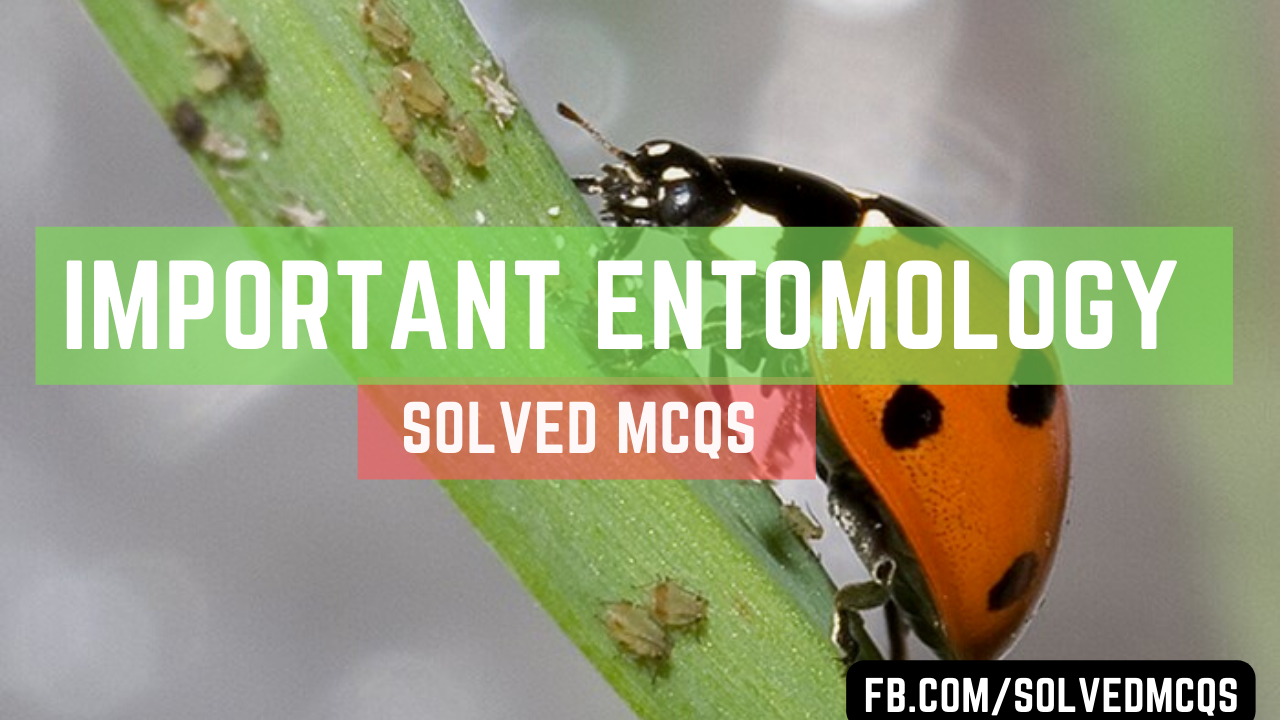Entomology multiple-choice Questions MCQs with Answers 1. Entomology is the branch of zoology concerned with the study of: a. Bi...
Entomology multiple-choice Questions MCQs with Answers
1. Entomology is the branch of zoology concerned with the study of:
a. Birds
b. Mammals
c. Insects
d. Reptiles
Answer: c. Insects
2. Which of the following is the smallest order of class Insecta?
a. Hemiptera
b. Odonta
c. Zeroptera
d. Coleoptera
Answer: c. Zeroptera
3. Who coined the term pest management?
a. Geier
b. Bartlett
c. Dr. Perry
d. Dr. Ray F. Smith
Answer: a. Geier
4. Piercing and sucking type of mouthparts are found in:
a. Cotton leaf roller
b. Coton jassid
c. Mustard aphid
d. Pink bollworm
Answer: c. Mustard aphid
5. Pollination by beetles is known as:
a. Melittophily
b. Myophily
c. Cantharophily
d. Myrmecophily
Answer: c. Cantharophily
6. Law of tolerance was proposed by:
a. Victor Shelford
b. F. F Blackman
c. Justus Liebig
d. Carl Mobius
Answer: a. Victor Shelford
7. The scientific name of the banana aphid is:
a. Thrips florum
b. Pentalonia nigroneruosa
c. cosmopolites sordidus
d. Yirachola Isocrates
Answer: b. Pentalonia nigroneruosa
8. Pheromones are synthesized by:
a. Thoracic glands
b. Glandular epidermal cells
c. Neuro secretory cells
d. All of mentioned above
Answer: b. Glandular epidermal cells
9. Sanjose scale is a pest of:
a. Almond and apple
b. Pear and plum
c. Mango and guava
d. Banana and papaya
Answer: a. Almond and apple
10. Bagging of pomegranate fruits with polythene cover is done to avoid damage from:
a. Butterfly sucking moth
b. Fruit borer
c. Shoot hole borer
d. Fruit fly
Answer: a. Butterfly sucking moth
11. Ladybird beetle is a predator of:
a. Aphid
b. Scale insect
c. Mites
d. All of these
Answer: d. All of these
12. The best method of controlling stored grain pests is:
a. Fumigation
b. Systemic insecticides
c. Proper drying and storage
d. Biological agents
Answer: a. Fumigation
13. Stripping of sugarcane leaves minimizes the attack of:
a. Mealybugs
b. Pyrilla
c. Early shoot borer
d. Top shoot borer
Answer: a. Mealybugs
14. The pest which attacks both infield and storage of pulses:
a. Pulse beetle
b. Gram pod borer
c. Red gram pod fly
d. Pod borer
Answer: a. Pulse beetle
15. Class Insecta has how many subclasses?
a. 3
b. 2
c. 4
d. 5
Answer: b. 2
16. Choose the correct statement about Entomology:
a. The study of Birds
b. The study of Insects
c. The study of Microbes
d. The study of plants
Answer: b. The study of Insects
17. What are the main characteristics of insects?
a. Insects have three main body parts
b. Three pairs of legs
c. Two pairs of wings
d. All of these
Answer: d. All of these
18. The resting and inactive stage in the insect life cycle is known as:
a. The egg stage
b. The Larva stage
c. The Adult stage
d. The pupa stage
Answer: d. The pupa stage
19. Which of the following is NOT a natural predator of brown planthopper (BPH)?
a. Red ants
b. Water striders
c. Bugs
d. Spiders
Answer: a. Red ants
20. Insects that feed on one type of food are known as:
a. Monophagous
b. Polyphagous
c. Omnivorous insects
d. Entomophagy
Answer: a. Monophagous
21. Insects belong to the phylum…?
a. Nematoda
b. Arthropoda
c. Mollusca
d. Platyhelminthes
Answer: b. Arthropoda
22. Which of the following insects is the carrier of grassy stunt pathogenic virus?
a. Red ants
b. Pink ants
c. Mollusca
d. Leafhoppers
Answer: d. Leafhoppers
23. Choose the correct statement about Entomophagy:
a. Refers to eating birds
b. Refers to eating insects
c. Refers to eating Microbes
d. Refers to eating fishes
Answer: b. Refers to eating insects
24. The larval stage of the mustard sawfly has how many legs?
a. 3 pairs
b. 2 pairs
c. 8 pairs
d. 10 pairs
Answer: c. 8 pairs
25. Choose the correct statement about the holometabolous insects:
a. These insects undergo complete metamorphosis
b. These insects undergo incomplete metamorphosis
c. These insects undergo partial metamorphosis
d. None of these
Answer: a. These insects undergo complete metamorphosis
26. Which of the following is NOT a part of the insect head?
a. Pronotum
b. Vertex
c. Antennae
d. Tentorium
Answer: a. Pronotum
27. Odontotermes obesus is the scientific name of…?
a. Cutworm
b. Red ant
c. Termite
d. Shoot borer
Answer: c. Termite
28. The process of killing pupa without changing the cocoon shell layer is known as:
a. Denier
b. Dupion
c. Stifling
d. Reeling
Answer: c. Stifling
29. Choose the correct statement about the immature scale insects?
a. Sliders
b. Crawlers
c. Gliders
d. None of these
Answer: b. Crawlers
30. The excreta of the earthworm is known as?
a. Vermi-manure
b. Vermicompost
c. Vermicast
d. All of these
Answer: c. Vermicast
31. The middle segment, behind the head and before the abdomen is known as?
a. Abdomen
b. Head
c. Thorax
d. None of these
Answer: c. Thorax
32. Choose the correct statement about why spiders are not classified into insects?
a. Spiders are venomous
b. Spiders have eight legs
c. Spiders have 2 division in their bodies
d. All of these
Answer: d. All of these
33. Choose the correct statement about the anatomy of a cockroach?
a. A pair of testes are present in the 2nd segment
b. A pair of ovaries are present in the 4th segment
c. The abdomen region of a cockroach is divided into 10 segments
d. The thorax of a cockroach is divided into 6 segments
Answer: c. The abdomen region of a cockroach is divided into 10 segments
34. Bugs breathe through holes on the outside of their bodies which are known as?
a. Gills
b. Nose
c. Nostrils
d. Spiracles
Answer: d. Spiracles








COMMENTS